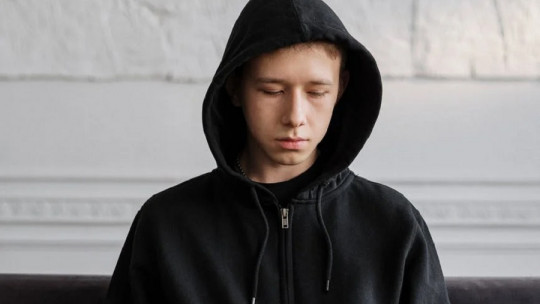Adolescence is a complex stage for many reasons. This is a transitional age between childhood and adulthood in which it is necessary to adapt to new responsibilities, new ways of relating to others, and the need to develop for the first time a consistent self-concept and sense of identity, linked to one’s role. that one has in front of society and with which one feels good. And to all this we must add a process of physical transformation and change in hormonal functioning.
Of course, managing all these changes is not easy and requires effort. But make no mistake, adolescence does not have to be a vital phase of strong psychological ups and downs or emotional or identity crises; There is nothing inherently painful about it. Taking this into account, Parents and educators should know that seeing adolescents suffering from high levels of anxiety is not and should not be normal. and that when these cases are detected, they must be helped and measures taken as soon as possible.
What forms does anxiety take in adolescence?
The most common anxiety disorders among young people are separation anxiety disorder (especially during childhood and early adolescence), social phobia, generalized anxiety disorder, and specific phobias. Its main characteristics are the following:
On the other hand, as time passes and the young person suffers the effects of this type of psychological alterations, the chances of you also starting to develop clinical depression increase , since anxiety disorders and mood disorders overlap greatly in the general population, including in adolescents. These psychopathologies constitute serious problems that greatly erode the quality of life of young people and that, in certain cases, can even lead to a form of symptoms as severe as suicidal ideation.
However, it must be taken into account that There are also frequent cases in which excess anxiety occurs but does not amount to a diagnosable psychopathology. ; That is, it is a propensity to experience moments in which anxiety accumulates a lot and/or encourages young people to adopt counterproductive patterns of behavior to try to alleviate this discomfort.
In cases like this, it is important to know that because high anxiety is not a disorder, it is no longer a problem that needs to be solved. Anything that involves helping young people to properly regulate their emotions and not letting stress and anxiety lead them to adopt harmful habits will be progress in maintaining their mental health.
Elements that favor the appearance of anxiety in young people
These are some of the factors capable of producing anxiety problems in adolescents.
1. Anxiety about seeking acceptance from other young people
The beginning of adolescence coincides with a period in which young people’s referents go from being parents to being other young people of similar age to oneself, and especially those who are a little older.
This often creates a feeling of disorientation. having to relate to others from new coordinates, adopting various behaviors associated with the concept of “the popular” and, in certain cases, this even leads some adolescents to compete with others for the attention of the rest of the members of that generation, and to become obsessed with not missing out on fashions and ways of expressing themselves that give a good image.
2. Insecurities with one’s own image and/or identity
Related to the previous anxiety-triggering element, we find the ease that adolescents have when it comes to developing insecurities related to their body and their image in general.
This occurs especially in girls, who tend to experience greater social pressure to hide what are often considered to be imperfections; In this way, they must actively work to always present their best appearance. Furthermore, the rapid and to some extent “disorderly” physical changes that adolescents’ bodies experience make it easy for many to not accept themselves as they are. Knowing this, it is not surprising that adolescence is a key stage in the appearance of eating disorders such as anorexia or bulimia.
3. Problems with organizing
The teenagers They do not have it as easy as adults to prioritize long-term goals ahead of short-term pleasures and satisfactions. This means that in many cases they do not organize their tasks well and postpone many of them indefinitely, their responsibilities accumulate and they end up feeling that the activities to be carried out overwhelm them.
4. Inexperience in conflict management
In adolescents, it is common to observe problems facing conflicts from a constructive attitude and seeking consensus; In many ways, they are less willing to take an external and global perspective on interest clashes. , and focus more on their own point of view, partly due to a lack of experience in conflict resolution. This means, for example, that strong arguments and frequent crises may occur in your group of friends.
5. Dependence on new technologies
The majority of adolescents in Western societies use social networks almost daily, even if only to see what others publish. In fact, it is through this medium that they find out most of the news in their circle of friends or social circle of reference, minute by minute. This means that the simple fact that their cell phone battery runs out while on the street can cause anxiety, through what is known as FOMO (Fear of Missing Out) syndrome.
Tips to help them overcome this form of discomfort
These are several guidelines that we as adults can follow to help adolescents manage anxiety.
1. Allow them to work on self-acceptance
This happens by not constantly calling their attention to their image to highlight the negative, and also by talk openly about the beauty in their features that deviate from the predominant beauty canons and in their wardrobe choices beyond the prevailing fashion codes.
2. Teach them relaxation techniques
There are many such techniques available, such as Mindfulness or Jacobson’s progressive muscle relaxation.
3. Give them support in their hobbies and pastimes
Hobbies are an excellent way to manage anxiety and to let go of intrusive thoughts that induce worry; Therefore, as parents we must give them support in the activities with which they decide to spend their free time, as long as they have a certain variety and include the active participation of friends their age.
4. Help them organize
Making it easy for them to comply with a more or less fixed work schedule will make them enjoy their free time more and associate satisfaction with the experience of carrying out their tasks, since they will know that they will complete them successfully and without problems. The latter, in turn, will reduce the likelihood that they will postpone these activities.
5. Give them tools to question social pressure
Help them develop critical thinking and question the fashions and ideas behind what is considered “cool” It will make it easier for them not to feel bad if from time to time they fall into the “unpopular” category. This is effective if at the same time we include the entire group of friends in it, making them gain autonomy to choose their own operating rules and their own values without always depending on what others think.
Are you looking for professional psychological support?
If you are interested in having psychological help for yourself or your sons or daughters, contact us.
In Psychomaster You will find both child and adolescent psychotherapy and for adults, as well as other services such as couples therapy or counseling for parents, and all of this offered by a team of psychologists with more than 14 years of experience helping people in the field. of psychological well-being. We offer face-to-face therapy (in our Madrid center) and also online therapy sessions. To see more information about us and our way of working, access this page.









